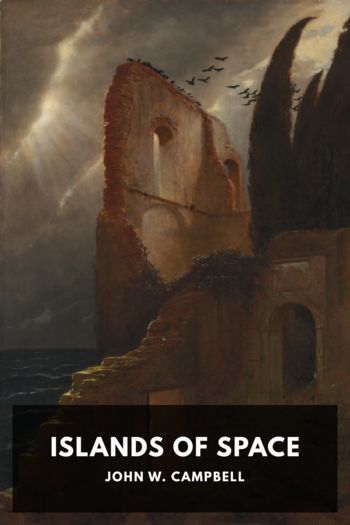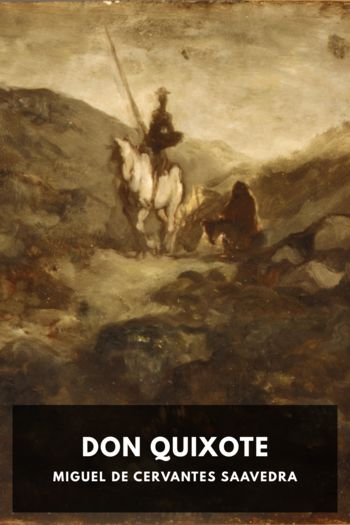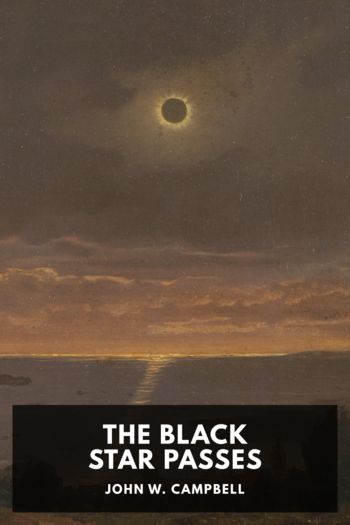Islands of Space, John W. Campbell [self help books to read TXT] 📗

- Author: John W. Campbell
Book online «Islands of Space, John W. Campbell [self help books to read TXT] 📗». Author John W. Campbell
Consciousness nearly left them; they had been burned in a dozen places by the leaping sparks.
Then it was over. Except that the ghost ships no longer followed them, the Ancient Mariner seemed unchanged. Around them, they could see the dim glowing of the galaxies.
“Brother! We came near something!” Arcot cried. “It may be a wandering star! Take a look around, quick!”
But the dark of space seemed utterly empty around them as they coasted weightless through space. Then Arcot snapped off the lights of the control room, and in a moment his eyes had become accustomed to the dim lights.
It was dead ahead of them. It was a dull red glow, so dim it was scarcely visible. Arcot realized it was a dead star.
“There it is, Morey!” he said. “A dead star, directly ahead of us! Good God, how close are we?”
They were falling straight toward the dim red bulk.
“How far are we from it?” Fuller asked.
“At least several million—” Morey began. Then he looked at the distance recorded on the meteor detector. “Arcot! For heaven’s sake do something! That thing is only a few hundred miles away!”
“There’s only one thing to do,” Arcot said tightly. “We can never hope to avoid that thing; we haven’t got the power. I’m going to try for an orbit around it. We’ll fall toward it and give the ship all the acceleration she’ll take. There’s no time to calculate—I’ll just pile on the speed until we don’t fall into it.”
The others, strapped into the control chairs, prepared themselves for the acceleration to come.
If the Ancient Mariner had dropped toward the star from an infinite distance, Arcot could have applied enough power to put the ship in a hyperbolic orbit which would have carried them past the star. But they had come in on the space drive, and had gotten fairly close before the gravitational field had drained the power from the main coil, and it was not until the space field had broken that they had started to accelerate toward the star. Their velocity would not be great enough to form an escape orbit.
Even now, they would fall far short of enough velocity to get into an elliptical orbit unless they used the molecular drive.
Arcot headed toward one edge of the star, and poured power into the molecular drive. The ship shot forward under an additional five and a half gravities of acceleration. Their velocity had been five thousand miles per second when they entered hyperspace, and they were swiftly adding to their original velocity.
They did not, of course, feel the pull of the sun, since they were in free fall in its field; they could only feel the five and a half gravities of the molecular drive. Had they been able to experience the pull of the star, they would have been crushed by their own weight.
Their speed was mounting as they drew nearer to the star, and Arcot was forcing the ship on with all the additional power he could get. But he knew that the only hope they had was to get the ship in a closed ellipse around the star, and a closed ellipse meant that they would be forever bound to the star as a planet! Helpless, for not even the titanic power of the Ancient Mariner could enable them to escape!
As the dull red of the dead sun ballooned toward them, Arcot said: “I think we’ll make an orbit, all right, but we’re going to be awfully close to the surface of that thing!”
The others were quiet; they merely watched Arcot and the star as Arcot made swift movements with the controls, doing all he could to establish them in an orbit that would be fairly safe.
It seemed like an eternity—five and a half gravities of acceleration held the men in their chairs almost as well as the straps of the antiacceleration units that bound them. When a man weighs better than half a ton, he doesn’t feel like moving much.
Fuller whispered to Morey out of the corner of his sagging mouth. “What on Earth—I mean, what in Space is that thing? We’re within only a few hundred miles, you said, so it must be pretty small. How could it pull us around like this?”
“It’s a dead white dwarf—a ‘black dwarf’, you might say,” Morey replied. “As the density of such matter increases, the volume of the star depends less and less on its temperature. In a dwarf with the mass of the sun, the temperature effect is negligible; it’s the action of the forces within the electron-nucleon gas which makes up the star that reigns supreme.
“It’s been shown that if a white dwarf—or a black one—is increased in mass, it begins to decrease sharply in volume after a certain point is reached. In fact, no cold star can exist with a volume greater than about one and a half times the mass of the sun—as the mass increases and the pressure goes up, the star shrinks in volume because of the degenerate matter in it. At a little better than 1.4 times the mass of the sun—our sun, I mean: Old Sol—the star would theoretically collapse to a point.
“That has almost happened in this case. The actual limit is when the star has reached the density of a neutron, and this star hasn’t collapsed that far by a long shot.
“But that star is only forty kilometers—or less than twenty-five miles in diameter!”
It took nearly two hours of careful juggling to get an orbit which Arcot considered reasonably circular.
And when they finally did, Wade looked at the sky above them and shouted: “Say, look! What are all those streaks?”
Arcing up from the surface





Comments (0)